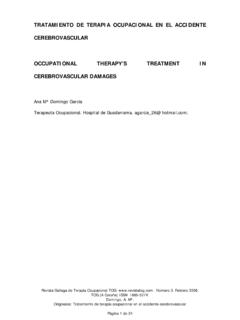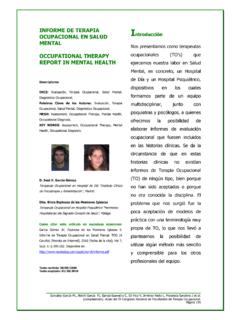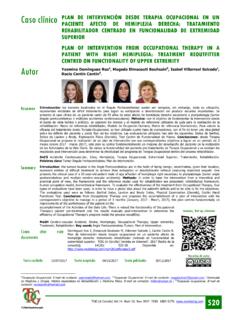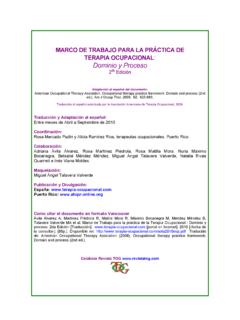Transcription of AN INTRODUCTION TO THE VONA Introduction …
1 TOG (A Coru a) Vol 8. Num 14. Sept 2011. ISSN 1885-527X. Page 1 de 26 AN INTRODUCTION TO THE VONA DU TOIT MODEL OF CREATIVE ABILITY INTRODUCCI N AL MODELO DE CAPACIDAD CREATIVA DE VONA DU TOIT Mesh: Occupational Therapy, Ocupation DECS: Terapia Ocupacional, Ocupaci n. Author: Wendy Sherwood MSc, DipCOT Senior Lecturer in Occupational Therapy, Head of the Model of Creative Ability Interest Group and the International Creative Ability Network. Quoted text: Sherwood W. An INTRODUCTION to the Vona du Toit model of creative ability.
2 TOG (A Coru a) [revista en Internet]. 2011 [-fecha de la consulta-]; 8(14): [26p.]. Disponible en: Received text: 01/06/2011 Text accepted: 01/08/2011 INTRODUCTION The Vona du Toit Model of Creative Ability (VdT MoCA) is known as an occupational therapy practice model based upon the theory of creative ability by Vona du Toit (1974). As detailed by de Witt (2005), the model is predominantly taught and applied in practice in South Africa, the place of its origin. The theory of creative ability has a 40 year history in South Africa, but is relatively new to occupational therapy practice elsewhere.
3 Over the past five years the model has gained significant interest in the United Kingdom (UK) where it is taught on four undergraduate OT BSc programmes, is applied in many services particularly in the field of mental health and has been the focus of a national and international conference in 2009 and 2010 respectively. Practical Model: An INTRODUCTION to the Vona du Toit Model of Creative Ability. TOG (A Coru a) Vol 8. Num 14. Sept 2011. ISSN 1885-527X. Page 2 de 26 SUMMARY The Vona du Toit Model of Creative Ability (VdT MoCA) is known as an occupational therapy practice model based upon the theory of creative ability by Vona du Toit (1974).
4 As detailed by de Witt (2005), the model is predominantly taught and applied in practice in South Africa, the place of its origin. RESUMEN El Modelo de Capacidad Creativa de Vona du Toit (Vdt MoCA) es conocido como un modelo de pr ctica de la terapia ocupacional basado en la teor a de capacidad creativa de Vona du Toit (1974). Tal y como ha explicado Witt (2005), el modelo se ense a y se aplica en la pr ctica predominantemente en Sud frica, su lugar de origen. Contributions to those conferences were made by OTs from Japan where the model is also in use. The theory of creative ability provides a logical but sophisticated theoretical explanation of how human beings develop and do as occupational beings.
5 However, gaining understanding of the theory through reading alone is problematic due to there being very limited literature. Rather than repeating the information on the theory found elsewhere, this paper expands on existing explanation in an attempt to make the theory of creative ability more accessible and understandable in basic terms. In doing so, this discursive paper draws upon the work of some of those thought to have influenced du Toit s thinking. The author s own knowledge and that of experts in the theory of creative ability is also used to inform this descriptive paper on the theory of creative ability.
6 This paper also provides a brief critique of a theory/model that has lacked scrutiny by the profession and lacks research. A full literature review cannot be provided here, however an overview is provided of some of research undertaken to date. Theory of creative ability: history Since the untimely death of its author Vona du Toit in 1974, the theory of creative ability has been referred to as a theory, model, frame of reference and approach (van der Reyden 1984). With the advent of OT models, since the 1980s the theory of creative ability has also been known as the Model of Creative Ability as detailed by de Witt (years 2005), unofficially known as the Model of Creative Participation and also, Motivation and Action (Casteleijn and Smit 2002).
7 In response to criticism of this lack of agreement in the name of the model by Sherwood (2009a), the model was officially renamed as the Vona du Toit Model of Creative Ability in 2010. Author: Sherwood W. TOG (A Coru a) Vol 8. Num 14. Sept 2011. ISSN 1885-527X. Page 3 de 26 Although debate and argument for or against its status as a model, frame of reference or approach is absent from the literature, there can be no doubt that Vona du Toit was developing a theory of creative ability up until her death. A booklet entitled Patient volition and action published by the Vona and Marie du Toit Foundation (du Toit 1991, 2006) is comprised of papers and presentations by Vona du Toit between 1962 and 1974.
8 These document some of the early development of the theory of creative ability with references to some of the influences on du Toit s thinking such as Buber (existentialism), Frankl, Rogers (phenomenology) and Maslow (motivation theory). An occupational therapist and a psychiatrist, Weinstein and Schossberger (1964) are widely accepted to have had a significant influence, and Piaget s influence is also apparent. This range of influences upon du Toit s knowledge of occupational therapy resulted in the theory of creative ability as an occupational therapy theory. Similar to stages of development, du Toit describes levels of ability (creative ability) and therefore the theory of creative ability is most readily identifiable as being from a developmental frame of reference.
9 However, the philosophical foundations of the theory are of significant importance. These relate to du Toit s conceptualization of the terms creative and creativity. Creative and creativity Du Toit recognized that creativity is a term that has great breadth and depth to its meaning and has many differing definitions provided by a range of disciplines (du Toit 1970 in du Toit 1991). As it is difficult to define, du Toit recommended that OTs confine themselves to more specific and functionally significant terms (du Toit 1970 in du Toit 1991, p22) of creative response (one s response to opportunities and demands with a readiness to exert effort to participate), creative participation (participation/doing), creative act (the tangible or intangible product as a result of participation) and creative ability.
10 However, the term creative itself is subject to multiple interpretations, most commonly that of being innovative, having imagination or artistic flair. Practical Model: An INTRODUCTION to the Vona du Toit Model of Creative Ability. TOG (A Coru a) Vol 8. Num 14. Sept 2011. ISSN 1885-527X. Page 4 de 26 However, this is not the meaning within the theory of creative ability. Rather, to be creative and to have creativity has a more philosophical meaning. To be creative is to have the ability to create. The process of creating is creativity which is the process of creating something that did not exist before to the person creating it: By one s own intensely experienced action, something arises which was not there before (Buber 1947).










